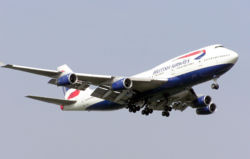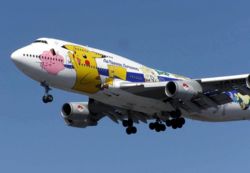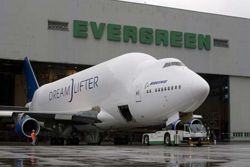PlaneSpottingWorld welcomes all new members! Please gives your ideas at the Terminal.
Boeing 747-400
| Boeing 747-400 | |
|---|---|
| Virgin Atlantic Airways Boeing 747-400 "Tinker Belle" taxiing to the take off point at London Heathrow Airport. | |
| Type | Airliner |
| Manufacturer | Boeing Commercial Airplanes |
| Maiden flight | 1988-04-29 |
| Introduced | 1989-02-09 (Northwest Airlines) |
| Developed from | Boeing 747 |
| Variants | Boeing 747-8 Boeing YAL-1 |
The Boeing 747-400 is the only model of the Boeing 747 still in production and will remain the largest commercial airliner in service until the introduction of the Airbus A380 in 2007. The 400 series 747 is the best selling and the most advanced model of the 747 family. The aircraft will be superseded by the Boeing 747-8, expected to enter service in 2009.
The 747-400 was announced by Boeing in October 1985, was rolled out in January 1988 and first flew on April 29, 1988. Certification was received on January 10, 1989 with PW4000 engines, May 18, 1989 with CF6-80C2s and June 8, 1989 with RB211-524Gs. The first 747-400 was delivered to Northwest Airlines on January 26, 1989, with service entry on February 9. [1]
Contents
Variants
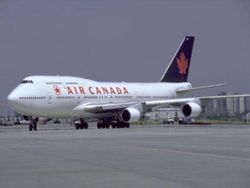
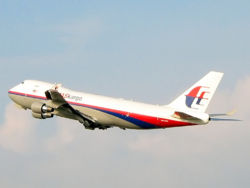
747-400
Compared to the 747-300 the 747-400 has 6 ft (2 m) wing tip extensions and 6 ft (2 m) winglets, an all-new glass cockpit which dispensed with the need for a flight engineer, tail fuel tanks, revised engines, an all-new interior, revised fuselage/wing fairings and newer in-flight entertainment to the basic design of the -300 series. Like the 747-300, the passenger version of the 747-400 included the stretched upper deck (SUD) as a standard feature. The SUD was almost twice as long as the standard upper deck; it had previously been offered as a retrofit and first appeared on two Japanese 747-100 SR models.[1] While the wingspan was increased, the overall weight of the wings was decreased due to the use of composites and aluminium alloys.
747-400F
The 747-400F (Freighter) is an all freight version which uses the fuselage design of the 747-200F. The aircraft's first flight was on May 4, 1993 and it entered service with Cargolux Airlines on November 17, 1993. Major customers include Atlas Air, Cargolux, China Airlines, Korean Air, Nippon Cargo Airlines, Polar Air Cargo, and Singapore Airlines. The -400F can be easily distinguished from the passenger -400 by its shorter upper-deck hump.
The United States Air Force has purchased seven 747-400Fs to act as "Airborne Laser" carriers, designated YAL-1A. The aircraft are heavily modified to carry a nose mounted turret and Chemical Oxygen Iodine Laser (COIL) equipment.
747-400M
The 747-400M (a passenger/freight or "Combi" variant) first flew on June 30, 1989 and entered service with KLM on September 12, 1989. The -400M has a large cargo door fitted to the rear of the fuselage.
747-400D
The 747-400D (Domestic) is a high density seating model developed for short-haul domestic Japanese flights. Capable of seating a maximum of 568 passengers, the aircraft is the highest-capacity passenger aircraft in the world, even when the Airbus A380 officially enters service. The -400D lacks the wing tip extensions and winglets included on other variants, allowing for increased number of takeoffs and landings by lowering wing stresses; the benefits of winglets would be minimal on short routes. The -400D may be converted to the long range version when needed.
The 747-400 Domestic first flew on March 18, 1991 and entered service with Japan Airlines on October 22, 1991.
747-400ER
The 747-400ER (Extended range) was launched on November 28, 2000 following an order by Qantas for 6 aircraft. The -400ER can fly an additional 805 km or carry 6,800 kg more freight. Qantas received the first -400ER on October 31, 2002. This model features a 777-style interior, also known as the Boeing Signature Interior.
The 747-400ER includes the option of 1 or 2 additional 3240USG body fuel tanks in the forward cargo hold. Manufactured by Marshall Aerospace of Cambridge, UK, these tanks utilise cutting edge metal to metal honeycomb bonded technology to achieve an incredibly high dry weight to fuel volume ratio. Similar technology has been used in the development by Marshall of body fuel tanks for the 777-200LR and P-8A Poseidon MMA aircraft.
The Boeing Signature Interior is now available as an option on the base 747-400, as interior refitting on existing 747-400s or as a "fresh-from-installation" option on newer base 747-400s. One example, China Airlines's 2 newest Boeing 747-400s, (Tail Number B-1821x), were newly built with Boeing Signature Interior. One of the newest Boeing 747-400s (B-18210), has a combined Boeing/China Airlines livery painted in 787 Dreamliner colors.
747-400ERF
The 747-400ERF is the freight version of the -400ER, launched on April 30, 2001. The -400ERF was delivered to Air France (via ILFC) on October 17, 2002. The 747-400ERF has a maximum payload of 248,600 pounds (112,760 kg) and can carry 22,000 pounds (9,980 kg) more than other 747-400 freighters on long-range flights at maximum takeoff weight. It has a maximum range of 9,200 km, about 525 km farther than other 747-400 freighters, and has a strengthened fuselage, landing gear and parts of its wing, along with new, larger tyres.
The new 747-8 Freighter will have more payload capacity but less range than the current 747-400ERF.
747-400BCF
The 747-400BCF (Boeing Converted Freighter), formerly known as the 747-400SF (Special Freighter), is a conversion programme for standard 747-400s. The project was launched in 2004. The first Boeing 747-400BCF was redelivered to Cathay Pacific Cargo and entered service on December 19, 2005.
747 Large Cargo Freighter
Boeing announced in October 2003 that due to the length of time of marine shipping, air transport will be the primary method of transporting parts for the Boeing 787. Pre-owned passenger 747-400 aircraft are to be converted into an outsize, "Large Cargo Freighter" configuration, in order to ferry sub-assemblies to Everett, Washington for final assembly.[2] The LCF has a bulging fuselage similar to that of the Super Guppy or Airbus Beluga cargo planes used for transporting wings and fuselage sections. The conversion, designed by Boeing's Moscow office,[3] is to be carried out in Taiwan by a subsidiary of the Evergreen Group.[4] Boeing has purchased three former China Airlines aircraft which are currently being modified.
Compared to marine shipping, delivery times for the parts built in Japan will be reduced from around 45 days to four hours with the 747 LCF.[2] The Large Cargo Freighter can hold three times the volume of a 747-400F freighter.[5][6][3] Evergreen International Airlines, which is unrelated to the Evergreen Group, will be the operator of the LCF fleet.[2][7]
The LCF is not a Boeing production model and will not be sold to any customers or see any airliner operation, and will be for Boeing's exclusive use.
Current operators
Passenger
(sorted by number of 747 in fleet, then by name of operator)
- Template:Country data United Kingdom British Airways (57) (RB211)
- Template:Country data Japan Japan Air Lines (41) (CF6)
- Template:Country data Germany Lufthansa (30) (CF6)
- Template:Country data United States United Airlines (30) (PW4056)
- Template:Country data Australia Qantas Airways (30) (RB211/CF6)
- Template:Country data Netherlands KLM Royal Dutch Airlines (25) (CF6)
- Template:Country data Singapore Singapore Airlines (24) (PW4056)
- Template:Country data Japan All Nippon Airways (23) (CF6)
- Template:Country data South Korea Korean Air (23) (PW4056)
- Template:Country data Hong Kong Cathay Pacific (21) (RB211/PW4056)
- Template:Country data Thailand Thai Airways (18) (CF6)
- Template:Country data Malaysia Malaysian Airlines (17) (PW4056)
- Template:Country data France Air France (16) (CF6)
- Template:Country data United States Northwest Airlines (16) (PW4056)
- Template:Country data Taiwan China Airlines (15) (PW4056/CF6)
- Template:Country data Taiwan EVA Air (15) (CF6)
- Template:Country data United Kingdom Virgin Atlantic Airways (13) (CF6)
- Template:Country data China Air China (12) (PW4056)
- Template:Country data India Air India (15) (PW4056)
- Template:Country data New Zealand Air New Zealand (8) (CF6/RB211)
- Template:Country data South Korea Asiana Airlines (8) (CF6)
- Template:Country data South Africa South African Airways (7) (CF6/RB211)
- Template:Country data France Corsairfly (6) (PW4056)
- Template:Country data Philippines Philippine Airlines (5) (CF6)
- Template:Country data Saudi Arabia Saudi Arabian Airlines (5) (CF6)
- Template:Country data Israel El Al (4) (CF6)
- Template:Country data Argentina Aerolineas Argentinas (3) (PW4056)
- Template:Country data Indonesia Garuda Indonesia (3) (CF6)
- Template:Country data Fiji Air Pacific (2) (PW4056)
- Template:Country data Hong Kong Oasis Hong Kong (2) (PW4056)
- Template:Country data Morocco Royal Air Maroc (1) (CF6)
Cargo
(sorted by number of 747 in fleet, then by name of operator)
- Template:Country data South Korea Korean Air Cargo (19) (PW4056)
- Template:Country data Taiwan China Airlines Cargo (18) (PW4056/CF6)
- Template:Country data Singapore Singapore Airlines Cargo (16) (PW4056)
- Template:Country data Luxembourg Cargolux (13) (RB211/CF6)
- Template:Country data Hong Kong Cathay Pacific Cargo (8) (RB211/PW4056)
- Template:Country data United States Polar Air Cargo (6) (CF6)
- Template:Country data Malaysia Malaysia Airlines Cargo (6)
- Template:Country data China Air China Cargo (5) (PW4056)
- Template:Country data France Air France Cargo (5) (CF6)
- Template:Country data United States Atlas Air (5) (CF6)
- Template:Country data South Korea Asiana Cargo (5) (CF6)
- Template:Country data United Arab Emirates Emirates Skycargo (4) (CF6)
- Template:Country data Taiwan EVA Air Cargo (3) (CF6)
- Template:Country data United Kingdom Global Supply Systems (3) (CF6)
- Template:Country data Japan JAL Cargo (3) (CF6)
- Template:Country data Netherlands KLM Cargo (3) (CF6)
- Template:Country data China China Southern Cargo (2) (CF6)
- Template:Country data Hong Kong Dragonair Cargo (2) (PW4056)
- Template:Country data China Jade Cargo International (2) (CF6)
- Template:Country data Japan Nippon Cargo Airlines (2) (PW4056)
- Template:Country data Belgium TNT Airways (2) (CF6)
- Template:Country data China China Cargo Airlines (1) (CF6)
- Template:Country data China Great Wall Airlines (1) (PW4056)
- Template:Country data Netherlands Martinair Cargo (1) (PW4056)
Other use
(sorted by number of 747 in fleet, then by name of operator)
- Template:Country data United Arab Emirates Dubai Air Wing (4) (PW4056/CF6)
- Template:Country data United States Boeing (3)** (PW4056)
- Template:Country data Japan Government of Japan (2) (CF6)
- Template:Country data Saudi Arabia Kingdom Aircraft Leasing (2) (PW4056)
- Template:Country data Oman Royal Flight of Oman (2) (CF6)
- Template:Country data United Arab Emirates Abu Dhabi Amiri Flight (1) (PW4056)
- Template:Country data Brunei Government of Brunei (1) (CF6)
- Template:Country data Kuwait Government of Kuwait (1) (CF6)
- Template:Country data Saudi Arabia Government of Saudi Arabia (1) (CF6)
- Template:Country data United States United States Air Force (1) (CF6)
Specifications
References
- ↑ About the 747 Family, Boeing, retrieved 12 June, 2006
- ↑ 2.0 2.1 2.2 "Ugly in the Air: Boeing's New Plane Gets Gawks, Stares." Lunsford, J. L. The Wall Street Journal. January 8, 2007.
- ↑ "Boeing Selects EGAT for 747 Large Cargo Freighter Modifications." Boeing Commercial Airplanes press release. February 18, 2005.
- ↑ "Boeing 7E7 Will Use Air Transport for Component Delivery." Boeing Commercial Airplanes press release. October 13, 2003.
- ↑ Boeing's 747 Large Cargo Freighter Development on Plan, Boeing, 22 February, 2005, retrieved 12 June, 2006
- ↑ "Evergreen International Airlines, Inc. to Operate Boeing 747 Large Cargo Freighters." Boeing Commercial Airplanes press release. December 15, 2005.
External links
Related content
Related development
Comparable aircraft
Designation sequence
See also
Template:Boeing airliners
Giant aircraft | |
|---|---|
| Production | |
| Prototypes | |
| Concepts | Proposed: Airbus A380-900 · Reaction Engines A2 · Beriev Be-2500 · Boeing 747-8 · Abandoned: Boeing New Large Airplane · Boeing Pelican · McDonnell Douglas MD-12 |
| Wingless aircraft | Biggest airship: Luftschiffbau Zeppelin Hindenburg class · Biggest blimp: Goodyear ZPG-3W · Biggest helicopter: Mil Mi-12 |
Lists relating to aviation | |
|---|---|
| General | Timeline of aviation · Aircraft · Aircraft manufacturers · Aircraft engines · Aircraft engine manufacturers · Airports · Airlines |
| Military | Air forces · Aircraft weapons · Missiles · Unmanned aerial vehicles (UAVs) · Experimental aircraft |
| Notable incidents and accidents | Military aviation · Airliners · General aviation · Famous aviation-related deaths |
| Records | Flight airspeed record · Flight distance record · Flight altitude record · Flight endurance record · Most produced aircraft |
es:Boeing 747-400 fr:Boeing 747-400 hu:Boeing 747-400 ja:ボーイング747-400
